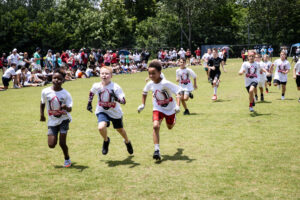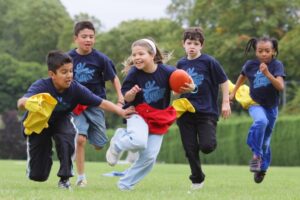Physical fitness strengthens your children’s bones, muscles, lungs, and heart. But did you know it can also improve their academic performance? Read on to find what the latest evidence says.
Increasing your children’s physical fitness is an effective way to improve their academic performance. Healthy children are more likely to become healthy adults. Help your children reach their maximum potential by instilling healthy habits.
Physical fitness – your ability to perform a specific exercise at your best – has long been revered for its incredible health benefits.
Emerging evidence shows physical activity helps people of any age improve their physical and mental health.
Physical Fitness Fast Facts
- The CDC recommends ≥ 1 hour of moderate-to-intense physical activity/day for 6- to 17-year olds.1¹
- The WHO recommends ≥ 1 hour of moderate-to-intense physical activity/day for 5- to 17-year olds.2²
- Only 1 in 4 high school students get the recommended hour of daily physical activity.3³
- About 14.4 million American children and adolescents (2-19 years) are obese.44
- Childhood obesity may increase the risk of:
-
- High blood pressure
- High cholesterol levels
- Type 2 diabetes
- Breathing problems, such as asthma
- Muscle weakness
- Fatty liver disease
- Digestive issues, such as heartburn and indigestion
- Anxiety and depression
- Overweight or obese children are more susceptible to bullying.55
What is Physical Fitness?
Physical fitness is the ability to perform a physical task or specific exercise. Being fitter indicates you have greater chances of being healthy later in life.

The five components of physical fitness are:66
- Body composition. How much fat, bone, and muscle do you have in your body?
- Muscular strength. How much can you lift?
- Muscular endurance. How many times can you lift before you are exhausted?
- Flexibility. How well can you move your joints without feeling pain?
- Cardiorespiratory fitness. How much oxygen can your heart and lungs pump during physical exercise?
Exercises, such as swimming, walking, running, significantly enhance your children’s physical fitness.
Likewise, youth sports, including football, help build strength, flexibility, endurance, and cardiorespiratory fitness.
Understanding the Health Risks of Sedentary Behavior
Sedentary behavior is the time spent in activities that do not require movement. The most common example is screen time.
Sedentary children have a higher risk of being overweight or obese. Besides, they have a lower quality of life (QoL) compared to those who are active.77 The QoL measures your children’s:
- Physical, mental, and psychosocial health
- School functioning
- General health
5 Ways Physical Exercise (PE) Can Improve Your Children’s Academic Performance
1. Physical Exercise Affects Your Children’s Brain
Physical exercise affects specific brain areas that regulate memory, thinking, learning, and reasoning. It increases the levels of brain chemicals (neurotransmitters). Besides, it helps your brain form new nerve connections.
Aerobic exercises increase blood flow to your children’s hippocampus.88 Hippocampus is a brain structure involved in memory and learning. Likewise, exercise improves communication between brain cells (neurons).
Finally, physical activity helps your children’s brains make new neurons. It does so by increasing the levels of a protein called brain-derived neurotrophic factor (BDNF). BDNF helps neurons grow, mature, and sustain.
2. Physical Exercise Improves Academic Outcomes
Many studies show a positive link between exercise and academic outcomes. Academic outcomes comprise attention, memory, motivation, planning, and test scores.
One such study found that fitter students had greater white matter volume and better academic performance.99 Notably, the study highlighted the role of both aerobic exercise and muscle training. As such, it is wise to combine these two different forms of exercise for improved outcomes. 
Another study assessed how exercise affects academic performance in primary school children.1010 It noted that physical activity alone might improve children’s academic performance, independent of its effect on thinking skills.
The following measures can improve your children’s academic performance:1111
- School-based physical education
- Physical activity breaks during class
- Participation in extracurricular activities
3. Physical Exercise Boosts Physical Health
Optimal physical health is a key contributor to academic success. Active children have a lower risk of:
- Weak bones, muscles, or joints
- Respiratory problems
- Heart disease
- Overweight and obesity
- Bad posture
- Chronic diseases, including diabetes and heart disease
According to a study published in the Journal of Applied Physiology:1212
- Fitter children have fewer sick days.
- Low physical activity and high body fat increase the risks of respiratory infections.
- Children who exercise less than 3 hours a day have weak immune systems.
- Less active children have more frequent colds and flu.
4. Physical Exercise Fosters Emotional Health
Like physical health, emotional health is crucial to your children’s academic performance.
In the U.S., about 4.5 million children (3-17 years) have a behavior problem, and about 1.9 million have depression.1313 These problems severely impact children’s academic performance.
Children who exercise more have fewer episodes of depression, stress, and psychological distress. Furthermore, they have a healthy self-image, life satisfaction, and emotional well-being.
According to a team of Norwegian researchers,1414
- 6- to 8-year-olds who are active have fewer symptoms of depression 2 years later.
- Physical activity may relieve depression symptoms by boosting self-esteem.
5. Added Benefits for Children With Attention or Hyperactive Disorders
About 11 percent of U.S. children (5-17 years) have attention deficit hyperactivity disorder (ADHD).1515 ADHD causes hyperactivity, impulsiveness, and a short attention span.
Children with ADHD often have poor academic performance. Besides, disruptive behaviors make them more likely to be suspended.1616
Physical exercise helps them improve their:1717
- Anxiety and depression
- Thought and social problems
- Aggressive behavior
- Attention span
- Social competency
FAQs
Why is physical fitness important for students?
Physical fitness helps students stay healthy. It lowers their risk of anxiety, depression, obesity, heart disease, and diabetes.
How does physical activity affect academic performance?
Children who engage in regular physical activity have better attention, memory, and motivation. All these contribute to higher test scores.
References
- Centers for Disease Control and Prevention. How much physical activity do children need? Accessed 29 July 2021.
- World Health Organization. Global Recommendations on Physical Activity for Health. Accessed 29 July 2021.
- American Heart Association. Most of the nation’s teens aren’t getting enough exercise. Accessed 29 July 2021.
- Centers for Disease Control and Prevention. Childhood Obesity Facts. Prevalence of Childhood Obesity in the United States. Accessed 29 July 2021.
- Bacchini, Dario et al. “Bullying and Victimization in Overweight and Obese Outpatient Children and Adolescents: An Italian Multicentric Study.” PloS one vol. 10,11 e0142715. 25 Nov. 2015, doi:10.1371/journal.pone.0142715.
- American College of Sports Medicine. ACSM’s Health-Related Physical Fitness Assessment Manual. Accessed 29 July 2021.
- Wu, Xiu Yun et al. “The influence of physical activity, sedentary behavior on health-related quality of life among the general population of children and adolescents: A systematic review.” PloS one vol. 12,11 e0187668. 9 Nov. 2017, doi:10.1371/journal.pone.0187668.
- Chaddock-Heyman, Laura et al. “Aerobic fitness is associated with greater hippocampal cerebral blood flow in children.” Developmental cognitive neuroscience vol. 20 (2016): 52-8. doi:10.1016/j.dcn.2016.07.001.
- Esteban-Cornejo, Irene et al. “Physical Fitness, White Matter Volume and Academic Performance in Children: Findings From the ActiveBrains and FITKids2 Projects.” Frontiers in psychology vol. 10 208. 12 Feb. 2019, doi:10.3389/fpsyg.2019.00208.
- McPherson, A., Mackay, L., Kunkel, J. et al. Physical activity, cognition and academic performance: an analysis of mediating and confounding relationships in primary school children. BMC Public Health 18, 936 (2018). https://doi.org/10.1186/s12889-018-5863-1.
- Centers for Disease Control and Prevention. The Association Between School-Based Physical Activity, Including Physical Education, and Academic Performance. Accessed 29 July 2021.
- Cieslak TJ, Frost G, Klentrou P. Effects of physical activity, body fat, and salivary cortisol on mucosal immunity in children. J Appl Physiol (1985). 2003 Dec;95(6):2315-20. doi: 10.1152/japplphysiol.00400.2003. Epub 2003 Aug 8. PMID: 12909608.
- Centers for Disease Control and Prevention. Data and Statistics on Children’s Mental Health. Accessed 29 July 2021.
- Zahl T, Steinsbekk S, Wichstrøm L. Physical Activity, Sedentary Behavior, and Symptoms of Major Depression in Middle Childhood. Pediatrics. 2017 Feb;139(2):e20161711. doi: 10.1542/peds.2016-1711. Epub 2017 Jan 9. PMID: 28069664.
- Centers for Disease Control and Prevention. Attention Deficit Hyperactivity Disorder (ADHD). Accessed 29 July 2021.
- U.S. Department of Education. Identifying and Treating Attention Deficit Hyperactivity Disorder: A Resource for School and Home. Accessed 29 July 2021.
- Zang, Yu. “Impact of physical exercise on children with attention deficit hyperactivity disorders: Evidence through a meta-analysis.” Medicine vol. 98,46 (2019): e17980. doi:10.1097/MD.0000000000017980.
